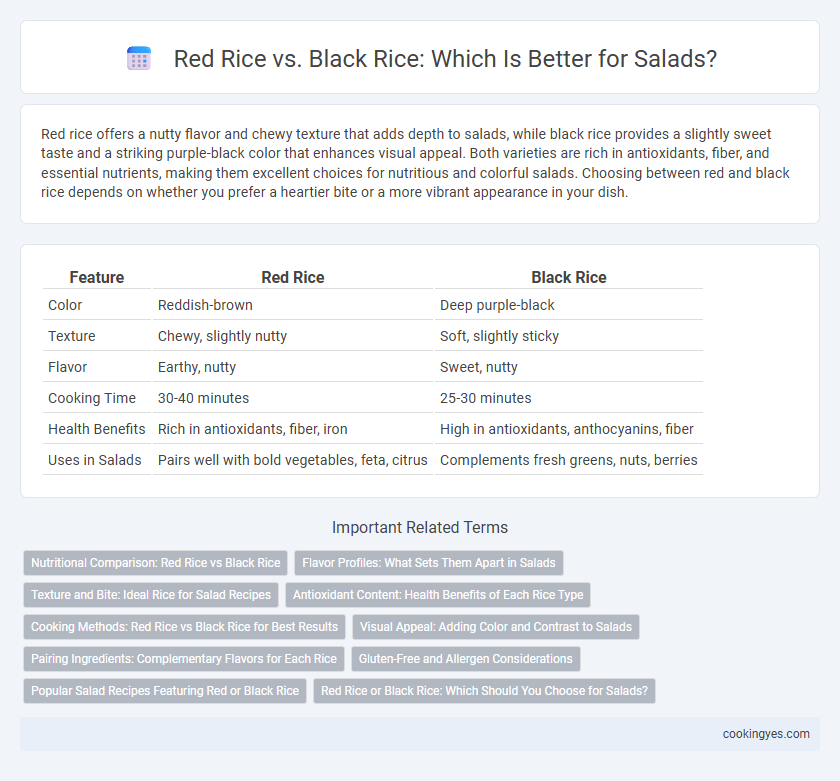Red rice offers a nutty flavor and chewy texture that adds depth to salads, while black rice provides a slightly sweet taste and a striking purple-black color that enhances visual appeal. Both varieties are rich in antioxidants, fiber, and essential nutrients, making them excellent choices for nutritious and colorful salads. Choosing between red and black rice depends on whether you prefer a heartier bite or a more vibrant appearance in your dish.
Table of Comparison
| Feature | Red Rice | Black Rice |
|---|---|---|
| Color | Reddish-brown | Deep purple-black |
| Texture | Chewy, slightly nutty | Soft, slightly sticky |
| Flavor | Earthy, nutty | Sweet, nutty |
| Cooking Time | 30-40 minutes | 25-30 minutes |
| Health Benefits | Rich in antioxidants, fiber, iron | High in antioxidants, anthocyanins, fiber |
| Uses in Salads | Pairs well with bold vegetables, feta, citrus | Complements fresh greens, nuts, berries |
Nutritional Comparison: Red Rice vs Black Rice
Red rice contains high levels of antioxidants, particularly anthocyanins, along with significant amounts of fiber, iron, and magnesium, making it a nutrient-dense choice for salads. Black rice surpasses red rice in antioxidant content, especially anthocyanin concentration, and provides substantial protein and vitamin E, supporting immune health and skin vitality. Both varieties offer complex carbohydrates and essential minerals, but black rice's enhanced antioxidant profile makes it particularly beneficial for nutrient-rich salad options.
Flavor Profiles: What Sets Them Apart in Salads
Red rice offers a nutty, earthy flavor that adds depth and a subtle sweetness to salads, enhancing ingredients like fresh herbs and citrus. Black rice provides a slightly chewy texture with a mildly sweet, almost balsamic taste that complements fruity and tangy salad components. Both varieties bring vibrant color and unique taste profiles, making them excellent choices for diverse, flavorful salads.
Texture and Bite: Ideal Rice for Salad Recipes
Red rice offers a nutty flavor with a firm, chewy texture that holds well in salads, providing a satisfying bite and preventing mushiness. Black rice features a slightly sticky, dense texture with a subtle earthiness, making it ideal for salads that benefit from a creamier mouthfeel without losing structure. Both varieties enhance salad recipes by adding unique textures and robust flavors that complement fresh vegetables and dressings.
Antioxidant Content: Health Benefits of Each Rice Type
Red rice contains high levels of anthocyanins and polyphenols, which contribute to its potent antioxidant properties, supporting cardiovascular health and reducing inflammation. Black rice boasts even higher antioxidant concentrations, particularly in the form of anthocyanins, which help combat oxidative stress and enhance immune function. Both red and black rice provide essential nutrients and unique antioxidant profiles that can boost the nutritional value of salads.
Cooking Methods: Red Rice vs Black Rice for Best Results
Red rice requires longer soaking and simmering times, typically 40-50 minutes, to achieve a tender yet chewy texture ideal for salads that benefit from a nuttier flavor. Black rice cooks in about 30-35 minutes and retains a firm, slightly sticky consistency that complements vibrant salad ingredients while adding a deep, earthy aroma. For best results, rinse both types thoroughly, use a water-to-rice ratio of about 2:1, and allow resting time off heat to enhance their unique textures and flavors in salads.
Visual Appeal: Adding Color and Contrast to Salads
Red rice offers a warm, earthy hue that enhances salad aesthetics with subtle color variation and a nutty texture, while black rice provides a striking deep purple-black shade and a slightly chewier bite, creating bold visual contrast. Incorporating red or black rice into salads not only elevates the dish's nutritional profile but also transforms the presentation by adding vibrant, natural color diversity that catches the eye. Both varieties complement fresh greens and bright vegetables, making salads more visually appealing and appetizing.
Pairing Ingredients: Complementary Flavors for Each Rice
Red rice's nutty flavor pairs well with earthy ingredients like roasted beets, sweet potatoes, and feta cheese, enhancing the salad's depth and texture. Black rice, with its slightly sweet and chewy profile, complements tropical fruits such as mango and pineapple, as well as fresh herbs like cilantro and mint, creating a vibrant and refreshing salad. Both rices benefit from citrus-based dressings and crunchy nuts, balancing their robust flavors while adding a satisfying crunch.
Gluten-Free and Allergen Considerations
Red rice and black rice both offer gluten-free options ideal for salads, catering to those with gluten intolerance or celiac disease. Red rice contains antioxidants like anthocyanins and a nutty flavor, while black rice provides higher levels of iron and fiber, beneficial for allergen-sensitive diets. Both varieties are free from common allergens such as nuts and dairy, making them safe, nutrient-dense choices for gluten-free salad recipes.
Popular Salad Recipes Featuring Red or Black Rice
Red rice and black rice are favored in popular salad recipes for their unique textures and rich nutrient profiles, offering high levels of antioxidants, fiber, and essential minerals. Salads featuring red rice often include ingredients like chopped vegetables, nuts, and tangy vinaigrettes, while black rice salads highlight sweet and savory elements such as mango, avocado, and sesame seeds. Both types of rice contribute robust color and flavor, making them ideal bases for vibrant, healthful salads rich in vitamins and phytonutrients.
Red Rice or Black Rice: Which Should You Choose for Salads?
Red rice offers a nutty flavor and chewy texture that enhances salads with a hearty bite and rich antioxidant content, including anthocyanins and iron. Black rice provides a slightly sweeter taste and dense, chewy grains packed with anthocyanins, fiber, and vitamins, making it a nutrient-dense option for vibrant, colorful salads. Choosing between red and black rice for salads depends on flavor preference and nutritional goals, with both varieties contributing unique textures and health benefits.
Red rice vs Black rice for salads Infographic

 cookingyes.com
cookingyes.com